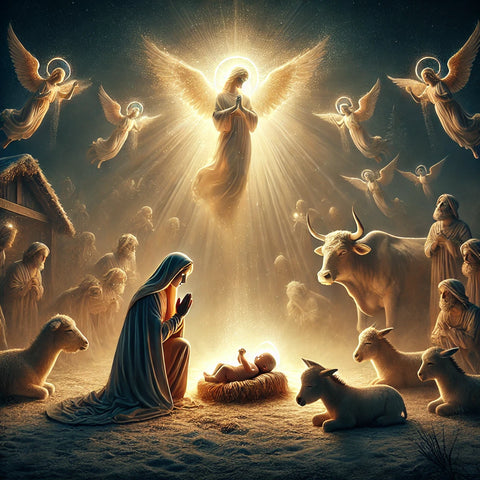The birth of Jesus Christ is one of the most sacred and celebrated events in human history. While the Gospels offer us a beautiful and concise account of this holy night, God, in His wisdom, allowed certain mystics and saints to witness and describe the Nativity with profound detail and heavenly insight. Among these, St. Bridget of Sweden, a 14th-century mystic, received one of the most vivid and awe-inspiring visions of the birth of our Savior.
Her revelations, recorded in her Heavenly Revelations, not only deepen our understanding of the Nativity but also invite us to reflect on the humility, love, and divine majesty surrounding the birth of Christ.
The Humble Setting: A Night of Expectation
St. Bridget begins her account by describing the humble surroundings of the Nativity. The Blessed Virgin and St. Joseph, unable to find lodging, sought shelter in a small cave or stable. St. Bridget's vision captures both the physical poverty and spiritual sanctity of the place:
"The Virgin knelt down in prayer and with great reverence stood in ecstasy. With her hands lifted toward Heaven and her eyes fixed on the skies, she was absorbed in divine contemplation. I saw the light of divine radiance surround her, and suddenly, the Child was born."
In this moment, the mystic sees Mary not as a woman suffering the pain of childbirth but as one enraptured by divine love. The setting, though modest, was illuminated by the glory of God, for heaven itself was present in this moment.
The Birth of Jesus: A Miracle of Light
St. Bridget’s description of Christ’s birth emphasizes its miraculous and supernatural nature. Unlike ordinary births, the Savior came into the world surrounded by divine light and purity. The scene she describes is striking:
"And when her Son was born, He came forth from her virginal womb with ineffable brightness and purity, and His body shone like the sun. The Blessed Virgin remained kneeling in prayer, her hands stretched out, and as soon as the Child was born, she adored Him with great honor and reverence, saying: ‘Welcome, my God, my Lord, and my Son!’"
This moment reveals the unity of Mary’s deep maternal love and her profound faith. In one breath, she calls Him my God and my Son, recognizing the divine and human nature of the Child lying before her.
The light that surrounded Jesus was not of this world:
"The infant lay on the earth, naked and shining. The very earth itself seemed to glow as if bathed in sunlight, for His divine radiance could not be contained. And behold, the ox and the ass, bending their knees, bowed their heads in reverence toward the Infant."
St. Bridget emphasizes the reverence even the animals showed toward their Creator. It is as if all of creation recognized the significance of this moment when the Creator entered His creation.
The Virgin Mary’s Tender Care
St. Bridget’s vision also highlights Mary’s tenderness as a mother. After the Child’s birth, she lovingly cared for Him, despite the humble surroundings:
"The Virgin took Him in her hands, pressed Him to her breast, and wrapped Him in the small cloths she had prepared with her own hands. Then she placed Him reverently in the manger, filled with hay, saying with tears of joy: ‘O Lord, You have come to redeem the world. I adore You with all my heart, and I praise You forever!’"
In this scene, we see Mary’s deep humility and her role as the first to adore Christ. She, who carried Him in her womb for nine months, was also the first to recognize and worship Him as the Savior of the world.
The Presence of the Angels
The humble stable was not without heavenly company. St. Bridget describes a heavenly host filling the space, singing in praise of the newborn King:
"Suddenly, I saw a great multitude of radiant angels appear, their voices so sweet and harmonious that no human tongue can describe them. They knelt before the Child, singing: 'Glory to God in the highest, and on earth peace to men of good will!' Their joy was uncontainable, and they praised the Lord with songs of heavenly beauty."
The angels, invisible to most eyes, celebrated the coming of the Savior. Their presence reminds us that the birth of Jesus was not just an earthly event but a cosmic one, in which Heaven itself rejoiced.
The Light of Christ: A Spiritual Lesson
St. Bridget’s vision of the Nativity calls us to reflect on the humility of God, who chose to be born in such poverty and simplicity. The radiant light of Christ shining in the darkness of the stable is a powerful reminder that God’s love knows no bounds. It is a light that dispels darkness, bringing hope to all mankind.
Her account invites us to approach the Infant Jesus with the same reverence as Mary, the shepherds, and even the animals:
- To bow our heads in worship, acknowledging Him as our Savior.
- To marvel at His humility, choosing a manger instead of a palace.
- To open our hearts to the light and love He brings into the world.
A Timeless Vision for Christmas
The vision of St. Bridget of Sweden is not just a beautiful retelling of the Nativity; it is a spiritual gift for all of us. It allows us to see the birth of Christ through heavenly eyes—reminding us of the holiness, peace, and wonder of that sacred night.
This Christmas, let us kneel beside Mary and the angels and pray with hearts full of love and gratitude:
“Welcome, my God, my Lord, and my Son!”
May the light of Christ, shining so brightly in St. Bridget’s vision, illuminate our hearts and homes this Christmas and always.

